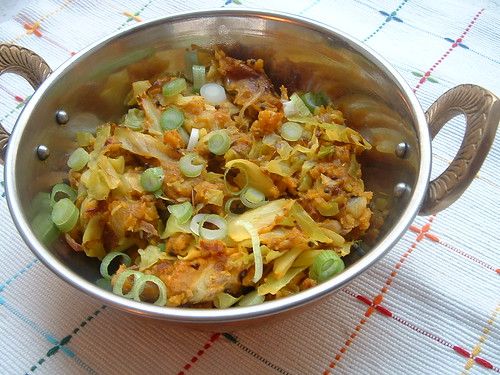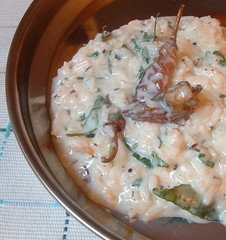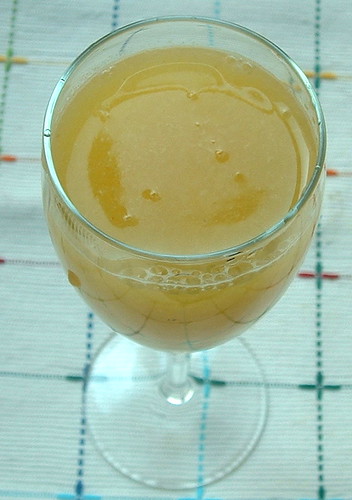Vital Stats:
1. Time it took to cover the alphabet: 6 months (11th September 2005 to 11th March 2006).
2. Most popular recipe: Egg Rassa
3. Number of dishes made: 33
Why did I do this series? I have a deep love for regional food. The kind of food that you cannot buy in a generic restaurant. The kind which requires an invitation into someone's home, where it is made by loving hands and served with pride. I always wanted to represent Marathi food on One Hot Stove and while thinking about this on a long subway ride (the "6" train downtown if you must know), two quintissentially Marathi dishes that came to my mind were "amti" and "zunka". Hey, wait, that's an A and a Z! How fun would it be to make a dish from every letter of the alphabet? I pulled out a used envelope and a pencil from my purse and scratched out all the letters and started jotting down possible recipes to make. To my surprise, it was very easy to fill up most of the alphabets (save I, J, O, X, Y...you know I had to "cheat" on these). But would anyone be interested? I tentatively wrote the "A" post and was startled by the interest shown by many readers...and the rest just followed on its own.
Why did I choose the recipes that I did? I am a home cook, with the task of making everyday meals. By this criterion, I chose recipes that were easy, tasty and nutritious. Which means that I did not make many sweets (like ladoos and pedhas), fried foods (of which there are dozens) and elaborate preparations (like bakarwadi and puran-poli), choosing instead to make simpler preparations that are ideal for everyday meals. Some of these dishes are unique to Marathi cuisine while others are popular in different parts of India in one version or another. It was amazing to discover this "unity in diversity"!
Is this the end of Marathi food on "One Hot Stove"? Absolutely not! I am not going to do another series on Marathi food (not just yet, anyway), but will continue to try many new Marathi recipes and share them with you.
The Complete Marathi Menu
Dals and Curries
1.
 Amti (Marathi-style Dal)
Amti (Marathi-style Dal) 2.
 Chavli Amti (Black-eyed Peas)
Chavli Amti (Black-eyed Peas)3.
 Egg Rassa (Egg Curry)
Egg Rassa (Egg Curry)4.
 Moogambat (Sprouted Mung Bean Curry)
Moogambat (Sprouted Mung Bean Curry)5.
 Pithale (Chickpea Flour Curry)
Pithale (Chickpea Flour Curry)6.
 Solkadi
Solkadi7.
 Usal
UsalRice
1.
 Dalimbay Bhaat (Sprouted Beans Pilaf)
Dalimbay Bhaat (Sprouted Beans Pilaf)2.
 Vaangi Bhaat (Eggplant Pilaf)
Vaangi Bhaat (Eggplant Pilaf)3.
 Waran-Bhaat
Waran-Bhaat4.
 Dahi Bhaat (Yogurt Rice)
Dahi Bhaat (Yogurt Rice)Vegetables
1.
 Bhendi Fry (Fried Okra)
Bhendi Fry (Fried Okra)2.
 Bharli Vaangi (Stuffed Baby Eggplants)
Bharli Vaangi (Stuffed Baby Eggplants)3.
 Fanas Bhaji (Green Jackfruit Stir-fry)
Fanas Bhaji (Green Jackfruit Stir-fry)4.
 Ratala Kees (Grated Sweet Potato)
Ratala Kees (Grated Sweet Potato)5.
 Cabbage Zunka
Cabbage Zunka6.
 Eggplant Kaap (Eggplant Slices)
Eggplant Kaap (Eggplant Slices)7.
 Kothimbir Vadi (Savory Cilantro Cake)
Kothimbir Vadi (Savory Cilantro Cake)Condiments
1.
 Hiravi Chutney (Green Chutney)
Hiravi Chutney (Green Chutney)2.
 Lasun Chutney (Garlic Chutney)
Lasun Chutney (Garlic Chutney)3.
 Koshimbir (Vegetable-Yogurt Salad)
Koshimbir (Vegetable-Yogurt Salad)Snacks
1.
 Chivda (Flattened Rice)
Chivda (Flattened Rice)2.
 Farazbi Patties (Green Bean Patties)
Farazbi Patties (Green Bean Patties)3.
 Jaali Chips (Potato Chips)
Jaali Chips (Potato Chips)4.
 Onion bhajjis (Onion Fritters)
Onion bhajjis (Onion Fritters)5.
 Bhadang (Puffed Rice)
Bhadang (Puffed Rice)One-dish meals
1.
 Misal
Misal2.
 Thalipeeth (Multi-Grain Pancake)
Thalipeeth (Multi-Grain Pancake)Sweets
1.
 Gharge (Fried Pumpkin Bread)
Gharge (Fried Pumpkin Bread)2.
 Imperial Cocktail (Ice-cream Sundae)
Imperial Cocktail (Ice-cream Sundae)3.
 Naaral Wadi (Coconut Fudge)
Naaral Wadi (Coconut Fudge)4.
 Sheera (Semolina Pudding)
Sheera (Semolina Pudding) Beverages
1.
 Panha (Mango Drink)
Panha (Mango Drink) Popular Marathi dishes made outside of this series:
1. Sabudana (Sago) Khichdi
2. Batata Vada (Stuffed Potato Fritters)
3. Dodka Bhaji (Ridge Gourd Curry)
4. Shevaya Kheer (Semolina Pudding)
5. Bharli Mirchi (Stuffed Peppers)
6. Vaalache Bhirde (Hyacinth Bean Curry)
7. Paratlele Batate (Pan-fried Potatoes)
8. Kolhapuri Bakarwadi
9. Microwave Sabudana Khichdi

Typical Maharashtrian dishes tried and loved (from fellow bloggers):
1. Masale Bhaat from Ashwini
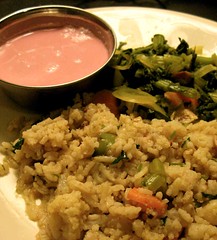
2. Microwave Besan Ladoo from Tee

3. Microwave Besan Ladoo from Nandita

More Maharashtrian Recipes from the Bloggers: Regional Cuisine event
Part I
Part II
Part III
Suggestions for Marathi Menus:
1. Humble Fare
Cabbage Zunka
Garlic Chutney
Plain steamed rice
Yogurt
Sliced onion
2. Luxurious Sunday Lunch
Farazbi patties
Egg rassa
Jeera rice
Koshimbir
Sheera
3. Tea Party
Masala chai
Onion bhajji
Bhadang
Naaral wadi
4. Home-style Weekday Dinner
Amti
Plain steamed rice
Bhendi fry
Koshimbir
5. Marathi-style Chaat Party
Misal
Chivda (garnished with raw onion, cilantro and lemon juice)
Panha
6. Light Dinner
Thalipeeth
Hiravi Chutney
Plain yogurt
7. Home-Alone Meal
Pithale
Plain steamed rice
Mango pickle
What next?
A few weeks ago, I was invited to my friend SR's home for dinner. SR lovingly prepared a complete vegetarian Bengali feast...Clockwise from bottom right, you can see (a) Cauliflower curry (b) Cholaar dal (chana dal) (c) posto'r bora (poppy seed-potato patties) (d) Tomato chutney (e) Dhokaar daalnaa (chana dal squares in tomato gravy) (f) steamed rice. All the flavors were so wonderful and exotic, I was left licking my fingers and relishing every morsel.
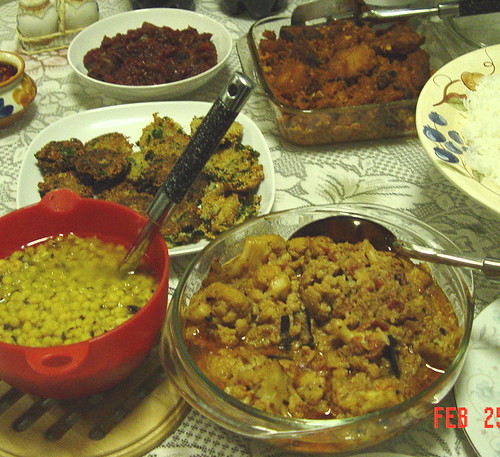
This dinner really brought it home to me...I love regional Indian food and want to study it more closely. SR and I are from one country, but we find each other's cuisines so novel. After exploring my own regional cuisine, I am ready to spread my wings and explore the whole country. So my next series is going to be a journey through all of India, stopping in every region and talking about its food and culture, learning some new recipes and tasting some new flavors. I want to make a little map where we can track our journey as we go along, down the west coast and up the east, then into the interior. Would you like to come along on this all-India foodie trek?
Finally, the announcement...
(Raise your hand if you skipped everything above and scrolled down to this bit) :) :)
Life in the next several weeks is going to get busy for me...I am about to take a ride on the matrimony pony. Yes, V and I are getting married on the 12th of April in India. We are both also reaching career milestones: V will defend his doctoral thesis and earn his PhD in two weeks, and I am in the final months of my own doctoral research.
In light of this whirlwind of events, One Hot Stove will be quiet for several weeks. I am going on a blogging hiatus till the end of April or so. I will be back with lots of foodie pictures from my India trip. If I get time, I'll stop by with some short posts for sure! Ciao!

